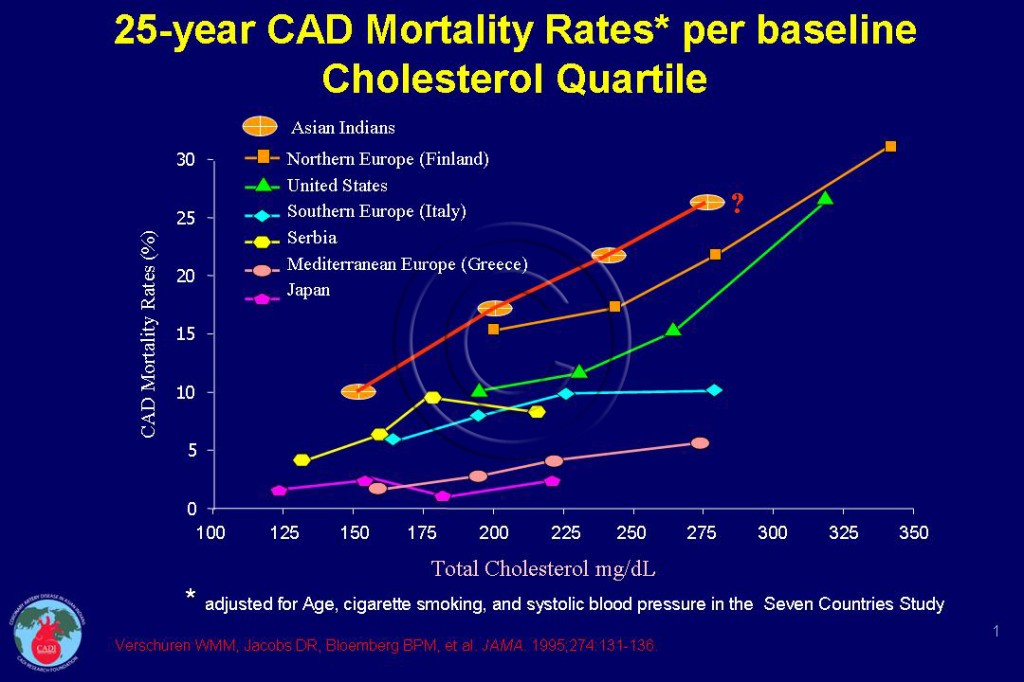Ethnic Differences in Heart Disease
- The terms race and ethnicity are often used together or interchangeably, their complex meanings merging. Race is a social construct of shared external characteristics and social history, with limited biologic validity.
- Ethnicity includes overlapping social and cultural features like ancestry, culture, customs, food, and language. It is evolving as a complex variable of health and disease.1
- Race and ethnicity affect health through complex and dynamic interactions of associated factors. Social, political and economic factors like income, deprivation, access, education, barriers, language differences, racism, different health systems, social networks, and others interact with biologic factors like smoking and obesity, to increase risk factors for disease .1
- The higher risk of heart disease among Asian Indians compared to all other populations at given levels of risk factors is shown in Figure 001.
- There are no genes for racial or ethnic groups, with more diversity within them rather than between them, although genetic studies can track geographic origins, population movements and disease associations.1
- Cardiac mortality varies substantially between countries and ethnic groups (20-fold between countries and 4-fold within the country depending on the ethnicity).2 (see Ethnicity and Heart disease)
- Several studies have conclusively demonstrated that Asian Indians, including vegetarians have a 50% to 400% higher age-standardized cardiac mortality compared with people of other ethnicity regardless of country of origin or residence (see Heart Disease Asian Indians).3-6
- At identical levels of traditional risk factors the coronary artery disease (CAD) mortality rates vary 5-fold with Japanese and Chinese having the lowest rates.7
- In sharp contrast, at a given level of risk factors Asian Indians have double the risk of heart disease than Europids. Asian Indians also have double the risk of severe heart disease (left main and 3-vessel disease).8-10
- Blacks have approximately 2-3 times lower chance of having severe heart disease (two or more diseased coronary arteries) than did whites after adjustment for multiple clinical characteristics and risk factors.11
Sources
1. Rambihar VS, Rambihar SP. Race, ethnicity, and heart disease: a challenge for cardiology for the 21st century. Am Heart J. Jan 2010;159(1):1-14.
2. Jha P, Enas E, Yusuf S. Coronary Artery Disease in Asian Indians: Prevalence and Risk Factors. Asian Am Pac Isl J Health. Autumn 1993;1(2):163-175.
3. Wild SH, McKeigue P. Cross sectional analysis of mortality by country of birth in England and Wales, 1970-92. Bmj. 1997;314(7082):705-710.
4. Harding S, Rosato M, Teyhan A. Trends for coronary heart disease and stroke mortality among migrants in England and Wales, 1979-2003: slow declines notable for some groups. Heart (British Cardiac Society). Apr 2008;94(4):463-470.
5. Yusuf S, Reddy S, Ounpuu S, Anand S. Global burden of cardiovascular diseases: Part II: variations in cardiovascular disease by specific ethnic groups and geographic regions and prevention strategies. Circulation. 2001;104(23):2855-2864.
6. Enas EA, Singh V, Gupta R, Patel R, et al. Recommendations of the Second Indo-US Health Summit for the prevention and control of cardiovascular disease among Asian Indians. Indian heart journal. 2009;61:265-74.
7. Tso DK, Moe G. Cardiovascular disease in Chinese Canadians: a case-mix study from an urban tertiary care cardiology clinic. The Canadian journal of cardiology. 2002;18(8):861-869.
8. Silbiger JJ, Ashtiani R, Attari M, et al. Atheroscerlotic heart disease in Bangladeshi immigrants: risk factors and angiographic findings. Int J Cardiol. Jan 29 2009.
9. Vallapuri S, Gupta D, Talwar KK, et al. Comparison of atherosclerotic risk factors in Asian Indian and American Caucasian patients with angiographic coronary artery disease. Am J Cardiol. 2002;90(10):1147-1150.
10. Okelo S, Taylor AL, Wright JT, Jr., Gordon N, Mohan G, Lesnefsky E. Race and the decision to refer for coronary revascularization: the effect of physician awareness of patient ethnicity. J Am Coll Cardiol. 2001;38(3):698-704.
11. Oberman A, Cutter G. Issues in the natural history and treatment of coronary heart disease in black populations: surgical treatment. Am Heart J. 1984;108(3 Pt 2):688-694.


